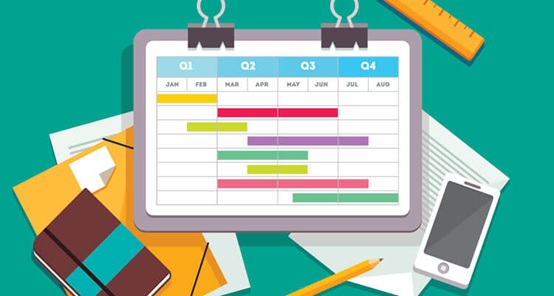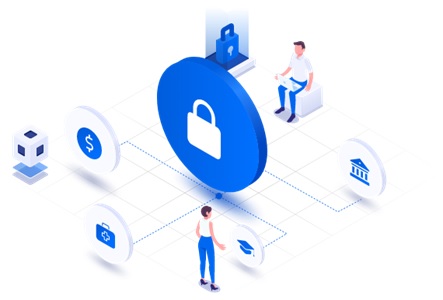A Gantt chart can simply be defined as a chart that contains the complete breakdown of all the sub-tasks of a project, the time allocated to each task, the resources assigned, the deadline of all the subtasks, and the benchmarks set. It also illustrates the interdependencies of the subtasks. This way, it makes sure every component of a project is completed within the set timeframe and with the said resources. It is one of the most useful ways of managing activities in project management.
Key features/components of a Gantt Chart
A Gantt chart is comprised of the following key components:
- i Date: This is the main component of a Gantt chart. No project management is complete without one knowing when to start and finish. In a Gantt chart, users can not only see the beginning and end date of the whole project but can also check out when each sub-task and process has to be started and completed, respectively.
- ii Tasks or subtasks: Every project has to be divided into several sub-tasks, which need to be completed one by one. Some also take place simultaneously in different environments and with the help of different resources. “Tasks” is the second main component of a Gantt chart. Every single task is listed in the order of preference with other relevant details alongside it.
- iii Task ID.Task ID is unique to each task to help users identify a certain task amongst various other tasks. Task ID makes it easy to identify and locate a particular task in the Gantt chart.
- iv Bars: Bars denote the time frame within which each listed task (in point ii) has to be completed. This helps project managers and team members to keep a track and ensure that every task is completed within the deadline. Any task that is lagging can be speeded up on time.
- v Each taskbar represents the portion of each sub-task and process that has been completed. The taskbar to the extent of the work completed is shaded for users to know how much work has been done. Taskbars help managers in having a quick glance at the progress of every process whenever needed.
- vi Arrows in a Gantt chart appear between the taskbars. What do they represent? They represent the relation between two or more tasks for users to know which task has to be completed first before proceeding on to another with which the previous one is related. This makes sure everything goes in the required order.
- vii Milestones: Milestones denote the desired result or outcome of a particular task, which determines its success. They are represented by diamonds to signify their importance so that everyone knows what needs to be achieved in that particular task to move forward to the next.
- viii Chat: The option to chat and text around tasks in a Gantt chart is essential to enable team communication in project management. This feature does away with the need to communicate outside the tool through email, call, and so on.
- ix Notifications and alerts: automatic alerts to team members essential to notify them when a particular task has been completed, updated or revised to keep them up to date with what changes were carried on and when.
- x File sharing: Gantt Charts allow users to attach files in the form of images, videos, docs, notes to a particular task so that necessary information can be checked right away while working on something. This saves your employees from having to keep looking at physical folders time and again.
Role of Gantt Charts in project management
Gantt Charts are extremely useful for project management as they work like the timeline of a project right from the planning stage to its delivery. They provide a detailed picture of a project and make it easy to manage. Let us understand in detail how they benefit project management:
- i Improved team collaboration
Effective communication and collaboration between team members are an integral part of any project, without which project management cannot take place successfully. No matter how good the strategies are, they can be implemented in the best manner only when everyone is aware of what needs to be done and when.
Gantt Charts are a perfect tool to eliminate the communication gap between team members. They provide insights into what work needs to be done, by whom, when and how. Everyone is aware of his or her responsibilities and his/her colleagues. Hence, communication is improved and work relationships are strengthened.
- ii Everything in one place
With Gantt charts, users do every basic thing related to a project in a single place. With the sub-tasks, processes, resources allocated, time frames, milestones, the order of tasks, and everything else in one place, managing the projects becomes easier as compared to using separate tools for everything. With just a glance on a Gantt chart, managers can point out what is going on in the project and what needs to be corrected.
- iii Judicious allocation and utilization of resources
The project timelines in Gantt Charts help you make a judicious allocation of resources and ensure that they are used wisely. Overuse of resources (both physical and manpower) will only burden your resource pool hampering your project and declining resource productivity. With proper management of resources, the success rates of projects are higher with every resource utilized in the best possible manner.
- iv Better time management
One of the most important advantages of the Gantt chart in project management is scheduling. Since the Gantt chart displays the breakdown of every task associated with a particular project, managers can smoothly allocate time to each task as per priority. Gantt charts provide a clear view of which tasks are lagging behind the scheduled timeframe and how the delay could affect the overall progress.
- v Helps in evaluating interdependencies of tasks
The sub-tasks and processes associated with a project are often related to each other with a few being completely independent. Since the majority of the tasks are interrelated, it becomes incomplete to complete a particular task without completing the previous one. Thus, interdependencies of tasks create a hurdle in the project’s progress, as a few team members often have to sit idle and wait for a particular task to get done. Gantt Chart helps in evaluating such interdependencies and scheduling tasks in a way that the whole process goes on smoothly and no one sits idle in the office.
- vi Boosts flexibility
Project planning does not always work out as planned. No matter how carefully the planning has been done, changes are inevitable. As per changing circumstances with time, your project requirements might change. Gantt Chart tools are flexible and allow for adjustments at any stage of the project without breaking the flow of work.
- vii Beneficial for remote workers
Gantt chart serves as the best project management tool when the team members of the project are working from remote locations. Most organizations these days provide the option of working remotely to their employees and have several offices/branches. Gantt Charts make it easier for remote team members to stay on the same page by providing everything at a single platform. Regardless of the difference in the region or time zone, everyone in the team is abreast of what is going on in the progress and what’s left to be completed. Read – Crystal Disk Info
- viii Promotes transparency and clarity
Gantt chart helps in promoting transparency in the processes by keeping everyone aware of each other’s job roles, responsibilities, and milestones. The ones with more experience can identify those struggling with some task and step ahead to help them in achieving the desired outcomes.
They also provide clarity on each aspect of the project and everyone understands the vitals of a project in the same manner. No one remains in any state of doubts or ambiguities minimizing room for confusion.
- ix Project evaluation made easy
Gantt Charts are the most effective way of measuring projects’ performances by comparing actual results with planned ones. They do not need to generate a detailed report every time they want to evaluate the progress. The birds’ eye view in the Gantt Chart gives them an idea about how things are going. Corrective steps can be taken before time to delay further severities.
- x Management of multiple projects
Managing multiple projects at the same time is no longer a hassle. Prioritizing tasks is difficult when a lot of projects are being handled at the same time by the same manpower. But with Gantt Charts, you can identify overlapping tasks and arrange them in the order of your priority. With a view of all the projects’ status in a single place, you can identify roadblocks and adjust the same to get everything on schedule.



